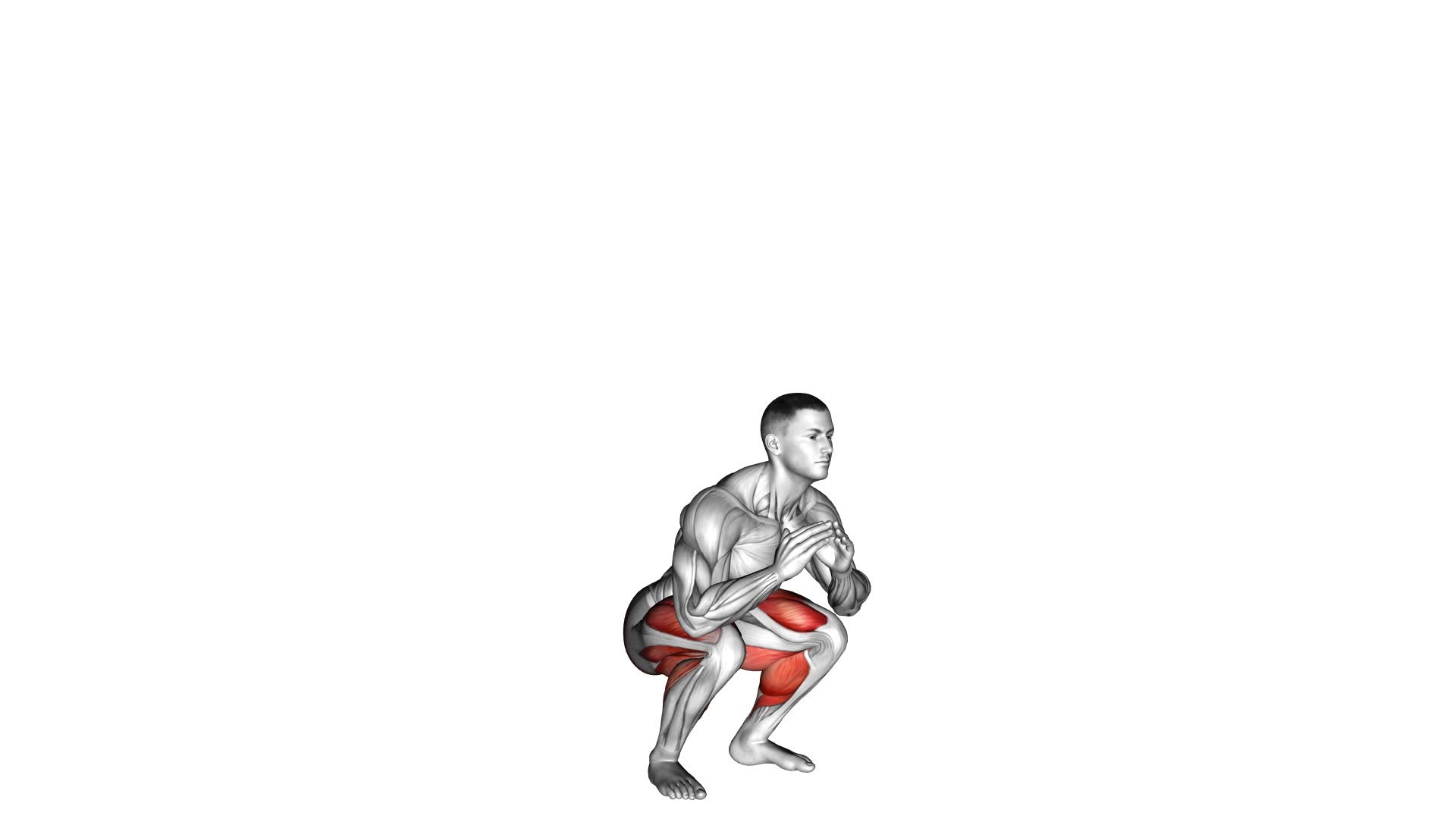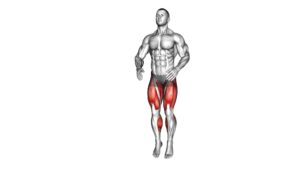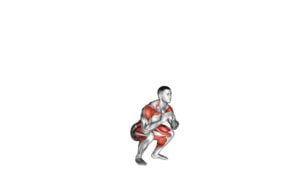Jump Squat – Video Exercise Guide & Tips

Are you looking to add some explosive power to your workouts? Look no further than jump squats!
Watch This Exercise Video
In this video exercise guide, we'll show you the proper form and technique for performing jump squats, as well as common mistakes to avoid.
Whether you're a beginner or a seasoned athlete, we've got modifications and advanced variations to suit your fitness level.
Get ready to maximize your results with these tips and start jumping your way to a stronger, fitter you.
Key Takeaways
- Jump squats improve explosive power and athletic performance.
- They target lower body muscles such as quadriceps, hamstrings, and glutes.
- Jump squats provide a cardiovascular challenge and help burn calories.
- Proper form and technique, including maintaining proper knee alignment and landing softly, are crucial to prevent injury.
Benefits of Jump Squats
Jump squats offer numerous benefits for your fitness routine. Incorporating plyometric training into your workouts can help improve your explosive power and overall athletic performance.
Jump squats specifically target the muscles of your lower body, including your quadriceps, hamstrings, and glutes. By performing explosive power training exercises like jump squats, you can increase your ability to generate force quickly, which is essential for activities such as sprinting, jumping, and changing direction rapidly.
Jump squats also provide a cardiovascular challenge, as they elevate your heart rate and require significant energy expenditure. This makes them an excellent addition to high-intensity interval training (HIIT) workouts, helping you burn calories and improve your cardiovascular fitness.
Furthermore, jump squats can enhance your coordination, balance, and stability. By engaging multiple muscle groups simultaneously, they improve your body's ability to work together efficiently, leading to better overall movement patterns and reducing the risk of injury.
To maximize the benefits of jump squats, it's essential to maintain proper form and technique. This will ensure that you engage the correct muscles and reduce the risk of strain or injury.
Proper Form and Technique
Now let's talk about the points to keep in mind when performing jump squats.
First, we'll discuss the benefits of incorporating jump squats into your workout routine.
Then, we'll address some common form mistakes to avoid in order to maximize the effectiveness of this exercise.
Jump Squat Benefits
To maximize the benefits of jump squats, focus on maintaining proper form and technique throughout the exercise.
Jump squats, also known as plyometric squats, are a great way to increase power and explosiveness in your lower body. Unlike regular squats, jump squats incorporate an explosive jump at the end of the movement, engaging more muscles and increasing the intensity of the exercise. This can lead to improved athletic performance, increased strength, and enhanced muscle definition.
Additionally, jump squats provide a cardiovascular workout, helping to burn calories and improve overall fitness. Variations of jump squats, such as single-leg jump squats or weighted jump squats, can further challenge your muscles and add variety to your routine.
Incorporating jump squats into your workouts can be a valuable addition to your fitness regimen.
Common Form Mistakes
One common mistake to avoid when performing jump squats is failing to maintain proper form and technique throughout the exercise. To prevent injury and maximize the benefits of this exercise, be mindful of the following common form mistakes:
- Allowing your knees to cave inwards: Keep your knees in line with your toes throughout the movement to avoid unnecessary strain on the knee joints.
- Not going low enough: Make sure to squat down until your thighs are parallel to the ground. This ensures that you're engaging your glutes and quadriceps effectively.
- Lack of control during the landing: When you jump, focus on landing softly and with control. Avoid landing with your knees locked or collapsing forward, as this can lead to injury.
Common Mistakes to Avoid
To prevent injury and maximize the effectiveness of your jump squats, it's important to be aware of common mistakes to avoid. By improving your jump squat technique and preventing jump squat injuries, you can ensure that you're getting the most out of this exercise.
One common mistake to avoid isn't maintaining proper form throughout the movement. It's important to keep your knees aligned with your toes and avoid letting them cave inwards. This can put unnecessary strain on your knees and increase the risk of injury. Additionally, make sure to keep your back straight and avoid rounding your shoulders. This will help to engage the correct muscles and prevent strain on your lower back.
Another mistake to avoid is using too much momentum instead of relying on your leg muscles to power the jump. It's important to explode upwards using the strength of your legs, rather than relying on a jerking motion or swinging your arms excessively. This will help to target the correct muscles and avoid strain on other areas of your body.
Lastly, make sure to land softly and absorb the impact by bending your knees. This will reduce the stress on your joints and prevent injuries such as sprained ankles or knee pain.
Modifications for Beginners
Are you new to jump squats and looking for modifications to make the exercise more beginner-friendly? If so, you're in the right place.
Jump squats can be a challenging exercise, but with a few modifications, you can still reap the benefits while gradually building strength and endurance.
Here are three modifications to consider:
- Reduced depth: Start by performing a regular squat without the jump. Focus on maintaining proper form and control as you lower yourself down and then stand back up. This modification allows you to build strength in your legs and core before adding the explosive jump.
- Squat and calf raise: Begin with a squat, just like the modified version above. As you stand up, add a calf raise by lifting your heels off the ground. This modification helps to engage your calf muscles and also improves balance and stability.
- Small jumps: Instead of jumping as high as you can, start with small jumps. Focus on landing softly and with control, absorbing the impact through your legs. As you become more comfortable and stronger, you can gradually increase the height of your jumps.
Advanced Variations for Seasoned Athletes
Now that you've mastered the basic jump squat, it's time to take your training to the next level with some advanced variations.
These alternative power exercises will challenge your muscles in new ways and help you continue to progress in your fitness journey.
Additionally, we'll discuss injury prevention strategies to ensure that you stay safe while pushing your limits.
Let's dive into these advanced variations and keep pushing towards your goals.
Alternative Power Exercises
Try incorporating explosive exercises like jump squats into your workout routine to challenge and develop your power as a seasoned athlete. These alternative power exercises are perfect for athletes looking to take their training to the next level.
Here are three plyometric training exercises that focus on explosive lower body movements:
- Box Jumps: Find a sturdy box that's around knee height. Stand in front of the box with your feet shoulder-width apart. Bend your knees and swing your arms back. Explosively jump onto the box, landing softly with your knees slightly bent. Step down and repeat.
- Medicine Ball Slams: Stand with your feet shoulder-width apart, holding a medicine ball above your head. Slam the ball down to the ground with all your force, catching it on the bounce. Repeat this explosive movement for a set number of reps.
- Tuck Jumps: Start in a standing position with your feet hip-width apart. Bend your knees and explode upward, bringing your knees towards your chest. Land softly with your knees slightly bent and repeat the movement.
Incorporating these explosive exercises into your training routine will help you develop power and explosiveness in your lower body, enhancing your overall athletic performance.
Injury Prevention Strategies
To prevent injuries as a seasoned athlete, incorporate advanced variations of injury prevention strategies into your training routine. These techniques are designed to help you stay injury-free and maintain optimal performance.
One of the most important aspects of injury prevention is incorporating effective warm-up exercises into your routine. Prior to any training session or competition, it's crucial to properly warm up your muscles and joints. This can be done through dynamic stretching, mobility exercises, and foam rolling. By increasing blood flow and flexibility, these warm-up exercises prepare your body for the demands of your sport and reduce the risk of injury.
Additionally, incorporating injury prevention techniques such as proprioceptive training, balance exercises, and strength training can further enhance your stability and resilience, helping you avoid common injuries that can sideline your athletic progress.
Tips for Maximizing Results
To maximize your results, focus on maintaining proper form and engaging your core throughout the jump squat exercise. This won't only help you get the most out of your workout, but also prevent common mistakes and reduce the risk of injury.
Here are three tips to help you maximize your results:
- Start with a proper warm-up: Before you begin any exercise, it's important to warm up your muscles to increase blood flow and flexibility. This will help prevent injuries and prepare your body for the jump squat. Spend a few minutes doing light cardio exercises, such as jogging or jumping jacks, followed by dynamic stretches for your lower body.
- Pay attention to your form: When performing the jump squat, make sure your knees are aligned with your toes and your back is straight. Avoid rounding your shoulders or leaning too far forward. Engage your core muscles to maintain stability and control throughout the movement.
- Gradually increase intensity: As you become more comfortable with the jump squat, gradually increase the intensity by adding weights or increasing the height of your jump. This will challenge your muscles and help you achieve better results over time.
Frequently Asked Questions
How Many Calories Can I Burn by Doing Jump Squats?
Jump squats are a great way to burn calories and work your lower body. By incorporating jump squat variations into your workout routine, you can increase the intensity and calorie burn.
When performing jump squats, it's important to maintain proper form to avoid injury and maximize results. Focus on keeping your chest up, knees in line with your toes, and landing softly on the balls of your feet.
Are Jump Squats Suitable for People With Knee Injuries?
Jump squats can be a challenging exercise, but if you have a knee injury, it's important to consider suitable modifications.
While jump squats can provide benefits like improving lower body strength and cardiovascular fitness, they also carry risks for those with knee injuries.
It's crucial to consult with a healthcare professional or a qualified trainer who can guide you on appropriate modifications and exercises that won't put excessive strain on your knees.
How Often Should I Include Jump Squats in My Workout Routine?
Jump squats are a great addition to your workout routine. They provide numerous benefits, such as increasing strength and power in your lower body, improving explosive movements, and boosting calorie burn.
Including jump squats in your routine a few times a week can be effective. Remember to start with proper form and gradually increase intensity.
There are also variations of jump squats, like single-leg jump squats and weighted jump squats, which you can incorporate for added challenge and variety.
Can Jump Squats Help Improve Vertical Jump Height?
Jump squats can definitely help improve your vertical jump height. By incorporating plyometric exercises like jump squats into your workout routine, you can increase your explosive power and enhance your overall athletic performance.
Jump squats specifically target the muscles in your lower body, including your glutes, quads, and calves, which are crucial for generating power and height in your jumps.
Adding jump squats to your routine regularly can lead to significant improvements in your vertical jump height over time.
Are Jump Squats More Effective for Building Muscle Than Regular Squats?
Jump squats are a great exercise for building muscle. Compared to regular squats, jump squats offer additional benefits. They engage more muscles, including your glutes, quads, and calves, resulting in increased muscle activation and growth.
The explosive nature of jump squats also helps improve power and athletic performance. Incorporating jump squats into your workout routine can be an effective way to build muscle and enhance overall strength.
Conclusion
Jump squats are an effective exercise for improving lower body strength and power. By incorporating explosive jumps into the squat movement, you can enhance athletic performance and increase calorie burn.
Remember to maintain proper form and avoid common mistakes such as rounding the back or allowing the knees to cave in.
Beginners can start with modified versions, while seasoned athletes can try advanced variations to challenge themselves.
Follow these tips to maximize your results and take your fitness to the next level.

Author
Years ago, the spark of my life’s passion ignited in my mind the moment I stepped into the local gym for the first time. The inaugural bead of perspiration, the initial endeavor, the very first surge of endorphins, and a sense of pride that washed over me post-workout marked the beginning of my deep-seated interest in strength sports, fitness, and sports nutrition. This very curiosity blossomed rapidly into a profound fascination, propelling me to earn a Master’s degree in Physical Education from the Academy of Physical Education in Krakow, followed by a Sports Manager diploma from the Jagiellonian University. My journey of growth led me to gain more specialized qualifications, such as being a certified personal trainer with a focus on sports dietetics, a lifeguard, and an instructor for wellness and corrective gymnastics. Theoretical knowledge paired seamlessly with practical experience, reinforcing my belief that the transformation of individuals under my guidance was also a reflection of my personal growth. This belief holds true even today. Each day, I strive to push the boundaries and explore new realms. These realms gently elevate me to greater heights. The unique combination of passion for my field and the continuous quest for growth fuels my drive to break new ground.







